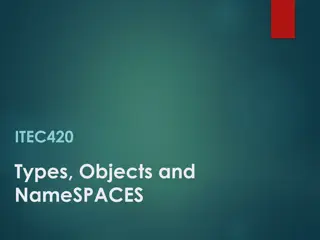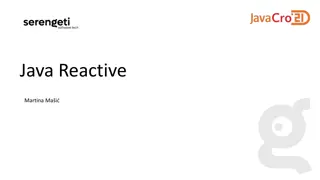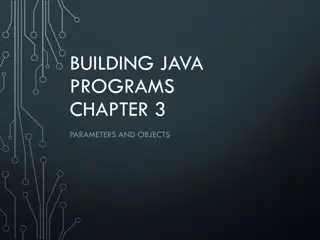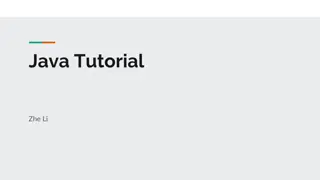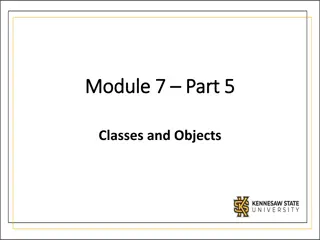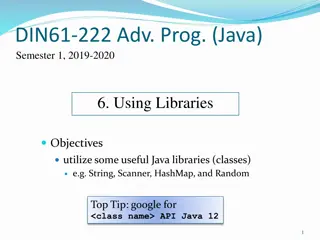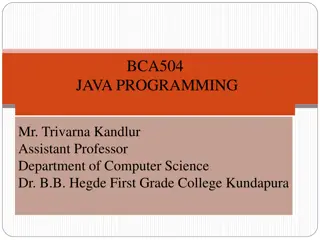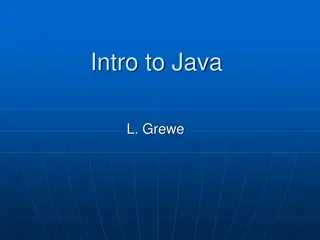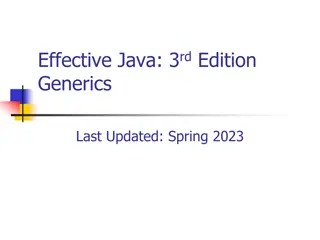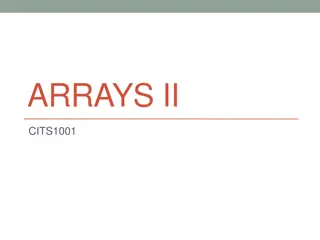Understanding Objects and References in Java Programming
Exploring the concept of objects and references in Java programming, this content delves into variables of a class type, memory management, and the behavior of class variables. It discusses how variables store memory addresses and highlights the efficiency of handling class types through references.
Download Presentation

Please find below an Image/Link to download the presentation.
The content on the website is provided AS IS for your information and personal use only. It may not be sold, licensed, or shared on other websites without obtaining consent from the author. Download presentation by click this link. If you encounter any issues during the download, it is possible that the publisher has removed the file from their server.
E N D
Presentation Transcript
1 CSC111 Adapted from: "JAVA: An Introduction to Problem Solving & Programming", 8th Ed. OBJECTS AND REFERENCES Ch5.3
2 CSC111 Adapted from: "JAVA: An Introduction to Problem Solving & Programming", 8th Ed. Objects and References: Outline Variables of a Class Type Defining an equals Method for a Class Boolean-Valued Methods Parameters of a Class Type
3 CSC111 Adapted from: "JAVA: An Introduction to Problem Solving & Programming", 8th Ed. Variables of a Class Type All variables are implemented as a memory location Data of primitive type stored in the memory location assigned to the variable Variable of class type contains memory address of object named by the variable
4 CSC111 Adapted from: "JAVA: An Introduction to Problem Solving & Programming", 8th Ed. Variables of a Class Type Object itself not stored in the variable Stored elsewhere in memory Variable contains address of where it is stored Address called the reference to the variable A reference type variable holds references (memory addresses) This makes memory management of class types more efficient
5 CSC111 Adapted from: "JAVA: An Introduction to Problem Solving & Programming", 8th Ed. Variables of a Class Type Figure 5.5a Behavior of class variables
6 CSC111 Adapted from: "JAVA: An Introduction to Problem Solving & Programming", 8th Ed. Variables of a Class Type Figure 5.5b Behavior of class variables
7 CSC111 Adapted from: "JAVA: An Introduction to Problem Solving & Programming", 8th Ed. Variables of a Class Type Figure 5.5c Behavior of class variables
8 CSC111 Adapted from: "JAVA: An Introduction to Problem Solving & Programming", 8th Ed. Variables of a Class Type Figure 5.5d Behavior of class variables
9 CSC111 Adapted from: "JAVA: An Introduction to Problem Solving & Programming", 8th Ed. Variables of a Class Type Figure 5.6a Dangers of using == with objects
10 CSC111 Adapted from: "JAVA: An Introduction to Problem Solving & Programming", 8th Ed. Variables of a Class Type Figure 5.6b Dangers of using == with objects
13 CSC111 Adapted from: "JAVA: An Introduction to Problem Solving & Programming", 8th Ed. Complete Programming Example View sample code, listing 5.19 class Species Figure 5.7 Class Diagram for the class Species in listing 5.19
14 CSC111 Adapted from: "JAVA: An Introduction to Problem Solving & Programming", 8th Ed. Boolean-Valued Methods Methods can return a value of type boolean Use a boolean value in the return statement Note method from listing 5.19
16 CSC111 Adapted from: "JAVA: An Introduction to Problem Solving & Programming", 8th Ed. Parameters of a Class Type When assignment operator used with objects of class type Only memory address is copied Similar to use of parameter of class type Memory address of actual parameter passed to formal parameter Formal parameter may access public elements of the class Actual parameter thus can be changed by class methods
17 CSC111 Adapted from: "JAVA: An Introduction to Problem Solving & Programming", 8th Ed. Programming Example View sample code, listing 5.21 class DemoSpecies Note different parameter types and results View sample program, listing 5.22 Parameters of a class type versus parameters of a primitive type class ParametersDemo
18 CSC111 Adapted from: "JAVA: An Introduction to Problem Solving & Programming", 8th Ed. Programming Example Sample screen output
19 CSC111 Adapted from: "JAVA: An Introduction to Problem Solving & Programming", 8th Ed. Summary Classes have Instance variables to store data Method definitions to perform actions Instance variables should be private Class needs accessor, mutator methods Methods may be Value returning methods Void methods that do not return a value
20 CSC111 Adapted from: "JAVA: An Introduction to Problem Solving & Programming", 8th Ed. Summary Keyword this used within method definition represents invoking object Local variables defined within method definition Formal arguments must match actual parameters with respect to number, order, and data type Formal parameters act like local variables
21 CSC111 Adapted from: "JAVA: An Introduction to Problem Solving & Programming", 8th Ed. Summary Parameter of primitive type initialized with value of actual parameter Value of actual parameter not altered by method Parameter of class type initialized with address of actual parameter object Value of actual parameter may be altered by method calls A method definition can include call to another method in same or different class



